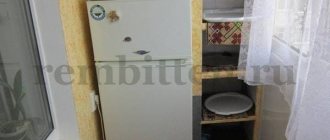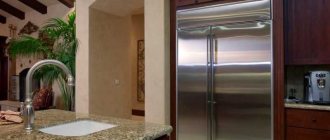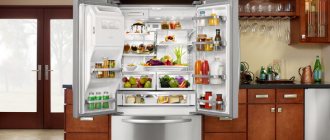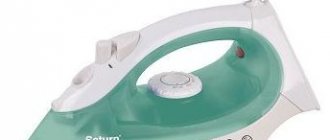Design features before installation
Each class implies certain climatic conditions, the level of humidity in the atmosphere, and the range of air temperatures. Depending on their combination, several classes are distinguished.
There are 4 main classes:
- Normal . Denoted by the letter N - normal. Refrigerators of this climate class can be placed on such a glazed balcony, where temperatures from +16 to +32 degrees Celsius are allowed. If the temperature exceeds the permissible level, then such a room should be air-conditioned.
- Subnormal or SN . operating mode of the refrigeration appliance is from +10 to +32. It is allowed to operate the unit in poorly heated rooms, but the temperature in which should not drop below the permissible +10 degrees.
- Subtropical . This is the climate class ST – subtropical. The compressor is capable of operating at temperatures from + 18 to + 38. Such refrigeration equipment is capable of operating in regions where the temperature and humidity of the environment are significantly increased relative to the normal climate.
- Tropical . T – tropical. Refrigeration appliances with this marking are capable of operating in hot, dry climates at temperatures from +18 to +43.
The climate class of the device should be selected based on the area of residence. This way the unit will work longer and will not cause hassle with compressor repairs.
Also, new models of refrigeration appliances with a large temperature range in which they can be operated are appearing on the household appliances market. These are “multi-class” models; they combine the properties of the 4 previous classes.
This:
- N-ST. From +16 to +38 degrees.
- N.T. From +16 to + 43 degrees.
- SN-ST. From +10 to +38 degrees.
- SN-T. From + 10 to + 43 degrees.
Multi-class refrigerators have both advantages in the form of wide possibilities for use on balconies and loggias, and disadvantages due to their energy consumption.
Refrigerator energy consumption class
The designs of refrigerators that belong to one class or another are different. This applies to the power of the compressor, layers of thermal insulation, materials used in the manufacture, and heat exchange area. The wider the temperature range of operation, the more complex the design, the more powerful the motor, the greater the power consumption and the higher the price.
Reasons why appliance manufacturers are against installing a refrigerator in an open space
Placing the refrigerator on an open balcony is fraught with frequent breakdowns, since the refrigeration unit will constantly be exposed to external natural influences. These are precipitation, high humidity, temperature changes. Each of these factors has a detrimental effect on the device and reduces its operating time.
You should take possible problems seriously if you have nowhere else to put the refrigerator.
Namely:
- Due to moisture, not only the electrical appliance is safe, but the safety of the entire apartment. Water and electricity are a bad combination that can lead to short circuits and fires. The body of the equipment is also sensitive to constant exposure to water; corrosion can form, which will also not add extra years to operation. Humid air can oxidize the contacts inside the refrigerator, damage the thermostat and the board that controls the unit
- Exposure to direct sunlight. This is another conditional enemy of household appliances. When exposed to direct sunlight, the varnish and paint on the body deteriorate, the rubber bands dry out and burst, which leads to depressurization of the refrigerator. Direct rays also create conditions under which the device heats up so much that the compressor may not withstand the load and burn out.
- A refrigerator or freezer on a balcony in winter is subject to the other extreme. These low temperatures are just as dangerous for the device as high ones. Both the refrigerant inside the line and the oil inside the refrigerator motor are sensitive to cold. Liquids thicken and prevent the processor from working properly. This is especially true for freon, a refrigerant whose condensate cannot return to the system due to low pressure, which forces the compressor to work harder and idle. This reduces the service life of the device.
You can set up a freezer on your balcony in winter without the help of equipment. This is a temporary, winter option, but practical in a climate zone where stable low temperatures remain for a long time.
To do this, you will need a box with a lid, insulation, reflective material Isolon, and sealant. The box, sealed except for the roof, is lined with sheets of insulation, and Izolon is applied on top of it. Such a DIY balcony freezer can be hidden in a seat, cabinet, closet, or a separate niche. It is worth storing not very demanding products, or for a short time, because such a chest is very sensitive to temperature changes. It is weather dependent rather than powered by electricity.
Read more in the article “How to make a box on the balcony.”
Is it possible to put
Operating the equipment on a balcony without heating will result in non-compliance with the operating parameters set by the manufacturer. Violation of the requirements will disable the equipment.
In order for the equipment to function longer, you need to:
- Decide on the purpose of using the refrigerator on the loggia. The freezer is chosen for storing meat and vegetables. For cooling drinks, non-freezing refrigerators of climate classes ST or T are more suitable. Models with two motors and FULL NO FROST equipment will cope with both tasks. Other devices will not operate at temperatures below 0°C.
- Select a unit of a suitable class for installation on the balcony during the hot period.
- When the air temperature is below +10°C, turn off the refrigerator on the loggia.
- Limit sun penetration into the room. Curtains and blinds made of dense materials will protect the unit from overheating and destruction of the paintwork.
- Install inexpensive equipment models. Soviet-era equipment often operates on balconies. It is easy to throw away if it breaks.
- Protect the refrigerator from getting wet and eliminate increased humidity in the room. The ventilation system and glazing of the loggia are methods of achieving the goal.
View » How to turn on the refrigerator correctly and after how long after defrosting
The installation of household appliances differs on balconies or loggias of different types.
On the open balcony
Refrigeration equipment is not protected from temperature changes, precipitation and dust. To the question of whether it is possible to place a refrigerator on the balcony in winter, there is a clear answer - absolutely not. The unit will not work on the loggia.
Possible installation problems:
- Snow and moisture falling on the electrical parts of the refrigerator can cause a short circuit and fire. Sockets and extension cords are prohibited from being installed in open areas.
- Winter - in cold weather, the oil in the compressor thickens, the engine runs idle. The pressure in the system decreases and freon stops functioning. As a result, the refrigerator stalls.
- Summer - under the influence of direct sunlight, the enamel coating of the case is destroyed and cracked. A compressor operating under increased load fails.
- The sealing rubber dries out due to temperature changes, and the door stops closing tightly.
On the glassed balcony
You need to know whether you can keep the refrigerator on an unheated loggia. There they are at risk. The motor runs to the limit, and at night the freon in the pipes freezes.
On a glazed balcony, separated from the rest of the room, the air temperature differs from that recommended by the manufacturer.
Condensation, which forms when the thermometer readings change, leads to corrosion of the metal casing.
A closed loggia is more suitable for installing a refrigerator. Glazing prevents direct precipitation from entering the equipment, but does not provide airtightness. In windy weather, some dust and precipitation gets inside the refrigerator.
It is extremely difficult to maintain a suitable temperature on a glazed balcony in extreme cold and heat; if it does not correspond to that indicated in the unit’s passport, the refrigerator will not turn on. You can turn off the refrigerator in winter and use it only in warm weather.
When determining what temperature is suitable for the equipment, users should know that today models are produced using new technologies with special freon that can withstand negative values.
Combined
There are no restrictions on installing household appliances on a balcony or loggia connected to a room. What microclimate is in the apartment is the same on the balcony, and:
- Glazing prevents cold air from penetrating into the loggia and does not transfer heat to the outside. To maintain the operating temperature of the refrigerator (+16…+30℃), room heating is needed. Installing a heated floor system or heaters will help solve the problem.
- Ventilation of the room will be required. Thick curtains or blinds reliably protect against the penetration of sunlight.
- Window profiles, insulation and the weight of refrigeration equipment place a significant load on the balcony slab. It is important to take these factors into account and calculate the permissible weight of structures and equipment in advance.
Is it possible to place a refrigerator on a glassed-in loggia?
A glazed balcony in itself eliminates a number of undesirable factors. Prevents direct sunlight, precipitation, and humid air. It remains to figure out the temperature regime for the room so that installing a refrigerator only brings benefits in the form of storing food, without burdening the owners with breakdowns and inconveniences.
Glazing type
There are two types of glazing - cold and warm. With the cold type, the temperature conditions outside and indoors differ by 5-6 degrees. Therefore, you should take into account to what extent the temperature can drop during a typical winter in the region of residence.
When installed on a relatively warm loggia, where the degrees will not fall below those allowed in the operating instructions, then such storage of products will not negatively affect the operation of the device. This means you can safely place the refrigerator on the balcony. In this case, the freezer will also serve well with a cold type of glazing in the room; its resources are better designed for cold environmental conditions.
Warm type of glazing. This is a room with a temperature that is as close as possible to the general temperature of the entire apartment. Some balconies are even part of the kitchen, as well as living spaces (more details in the article “kitchen design with a balcony”). At such a comfortable temperature, the refrigerator or freezer can operate without any problems.
Rules for installing and connecting the device
In addition to the temperature, humidity and strength of the balcony slab, the uninterrupted operation of the device is affected by proper installation and connection. These rules will help extend the life of the equipment and make the operating process safe:
- The base must be level and stable.
- The distance from the rear and side walls to the surfaces of the balcony must be at least 4-5 cm. This is necessary for sufficient air ventilation and to prevent overcooling of the device.
- It is not recommended to connect the device to the network through a carrying case. The outlet must meet all standards and be grounded.
- The device should not be located near batteries or heaters.
Related article: Insulation of a balcony with metal fencing
Wardrobe with built-in freezer for a heated balcony:
You can install the refrigerator on a glazed and well-insulated balcony. It would be good if it would be possible to additionally heat it in cold weather, as well as cool it in hot weather.
The technologies used in the latest models allow the device to operate even at ambient temperatures up to +5℃. At the same time, the load on all systems will be increased, which can lead to early wear of the equipment. Repair under warranty in this case is impossible, since the operating conditions were violated. If you have an old device, for which the warranty has long expired and you don’t mind parting with it if it breaks, then you can try placing it on the balcony. In any case, it is important to ensure fire safety and ensure the stability of the balcony base.
Loggia conditions and repairs
There are some parameters and conditions regarding the loggia design itself that should be taken into account before installing a refrigerator or freezer, especially on a hanging balcony. This is weight; not all balconies are able to withstand the weight of the refrigerator, as well as the food that is to be stored in it. You should also take into account the dimensions of both the balcony itself and the future refrigerator. It is worth taking care of the exact dimensions and their correspondence to each other. Read more in the article “What weight can a balcony support?”
There is no need to be overzealous with insulating the floor on the loggia directly under the refrigerator, especially for warm electric floors, which can have an effect even in a short time. Such conditions, elevated temperatures, can adversely affect the operation of the unit.
Particular attention should be paid to the electrical wiring on the balcony, its operating time and quality. This is necessary because in order to put the refrigerator on the balcony, you will need to run electricity there. You need to make sure that the electrical system can handle the load. This is especially true for energy-consuming units that will last a long time. Read more in the article “How to install electricity on a balcony.”
The windows should either be covered with a film that prevents direct sunlight from entering, or curtains should be hung to cover the refrigerator, especially during sunny times of the day. Read more in the article “How to close windows on a balcony from the sun.”
Freezer on the balcony
The most important difference between a refrigerator and a freezer is the temperature regime. The temperature in the first type of equipment ranges from conventional + 4 to + 7, while the second type operates in the range from – 18 to -24. Thus, a decrease in temperature is not as bad for a freezer as for a refrigerator, and vice versa, a warm room is more suitable for a refrigeration device than for a freezer. This is worth considering if these two types of equipment are combined into one device, or are stand-alone units.
Therefore, the refrigerator should be installed after making good insulation of the balcony. Whereas for normal operation of the freezer in winter, cold glazing of the balcony is quite suitable. This is facilitated by thermal regulation sensors; they react to the external temperature and when it becomes equal to the temperature of the refrigerator, it turns off.
The common weak point of both types of equipment is the oil in the compressor; it reacts equally poorly to cold weather conditions, especially to persistent negative temperatures.
In summer, it is necessary to equally carefully protect both the freezer and the refrigerator on the balcony. Both devices are exposed to high temperatures, which affects all their components.
Is it possible to put a freezer on the balcony?
In multi-storey buildings, apartments usually have balconies or loggias, but these premises are not intended without additional insulation or restructuring to accommodate and connect a freezer on the balcony or other electrical equipment, for the following reasons :
- There is no electrical wiring on the balcony and no connection point;
- The balcony is not closed, not insulated, the freezer on the balcony will freeze in winter;
- The temperature on the balcony corresponds to the street temperature;
- There is not enough space to install large equipment.
According to the technical documentation for the freezer, the optimal temperature during operation should be from +15°C, this condition is caused by the following circumstances:
- Compressor equipment uses various types of oil that can thicken at low ambient temperatures;
- The cooling technology in the refrigerator malfunctions at low ambient temperatures, which can lead to wear and failure of the compressor;
- When there are sudden changes in ambient temperature, a significant amount of condensate forms on operating equipment, which has a negative impact on the performance of the chamber and wear of the seals.
A freezer on a balcony, like a refrigerator on a balcony, can be installed in a room previously prepared in the construction plan, with insulation, power supply and preparation of the installation site for the unit.
The following conditions must be met :
- Balcony building structures must be strong, reliable, and able to withstand significant weight;
- The installation location of the freezer must be level, eliminate vibration and noise during operation of electrical appliances, and provide good ventilation;
- Thermal insulation. Windows must provide a stable, constant positive temperature in the room at any time of the year;
- Electrical wiring and connection points should be carried out in accordance with the rules of PUE and SNiP and in compliance with fire safety.
Also read on our website: Curtains for the balcony: making and installing them yourself
What kind of damage can occur if operating conditions are not followed?
A number of factors can impair the functionality of the refrigerator: power failure, moisture, short circuit. The refrigerator on the balcony is subject to the same breakdowns as any other refrigeration equipment.
The most common breakdowns can be:
- Compressor out of order. This is one of the most expensive breakdowns. Repairing an engine is just as expensive as replacing it with a new one.
- Failure in the control module department. Such a malfunction may be indicated by sound and light malfunctions in the general operation of the equipment; the control module also requires repair if one or both compartments of the refrigeration unit do not work. The most common cause of breakdown is high humidity in the room.
- Temperature sensor malfunction. If this device does not work, the refrigerant will not function productively, and the compartments will build up ice. Otherwise, the device simply will not work.
- Defrost sensor failure. In No Frost system refrigerators, such devices are fragile and are more often replaced than repaired.
- Door seal. If it has dried out, then it needs to be changed. This damage seems minor, but depressurization can lead to engine failure.
Breakdowns associated with using the refrigerator on the balcony
When operating a refrigerator on a balcony, the risk of various malfunctions occurring is quite high. For ease of perception , we have systematized the most common of them in the form of a table :
| Malfunction and how to fix it | Symptoms of a problem | Estimated cost of repair, including labor and parts |
| The refrigerator compressor has broken down . It needs to be replaced. | This malfunction occurs if the unit was operated at temperatures that do not correspond to the operating range specified in the instructions for the unit (this leads to increased load on the compressor). The following signs may indicate a breakdown::
| from 6500 to 10500 rub. |
| The control module has failed . It needs to be replaced or reflashed. | This malfunction can occur when the refrigerator is operated in conditions of high humidity: contacts oxidize and the control board fails. The following signs may indicate a malfunction::
An additional symptom may be a sound and light alarm from the refrigerator, indicating an increase in temperature in the chambers and/or an error code on the refrigerator display (for models with a screen). | Repair – from 3500 to 7000 rub. Replacement - from 9,000 rubles. |
| The temperature sensor is faulty (temperature regulator in electromechanical models or temperature sensor in electronically controlled models). It needs to be replaced. | Moisture condensation at the sensor location may cause breakdown, which can be indicated by the following symptoms (one or several at once):
| from 3000 to 6000 rubles. |
| The defrost sensor has failed (in refrigerators with NO Frost). It needs to be replaced. | Damage may occur due to moisture condensation on the sensor contacts. About the malfunction the following signs will signal:
Due to a malfunction of the sensor, the evaporator defrost does not turn on, and the refrigerator freezer is filled with ice. | from 4200 to 6500 rubles. |
| door seal has cracked and needs to be replaced. | This could happen:
A dried out seal leads to a violation of the refrigerator’s tightness, warm air getting inside it and an increase in the temperature in the chambers - this “forces” the compressor to work more intensively and can damage it. | from 2500 to 9000 rubles. |
Refrigerator on the loggia: suitable models, configurations
Refrigerators and freezers of different models differ in the number of compressors, temperature control of both the entire freezer and its individual compartments.
A refrigerator with one compressor can either have one temperature controller for all its compartments or have autonomous sensors and controls.
The first one will work the same way, building an acceptable temperature regime for the entire refrigeration device. The second will supply heat or cold for comfortable operation of the refrigerator or freezer separately and as needed; temperature regulation occurs due to drip cooling and manual defrosting in the freezer.
All these processes, heating and cooling, occur due to the refrigerant, freon. Single-compressor refrigeration units belong to the economy and mid-price segment.
There are refrigerators with two motors and a Full no frost system for the freezer. Each compressor, with its own refrigerant, serves the cooling compartment and the freezing compartment. The systems operate autonomously; control can be either on a common panel or on the doors of each compartment. Such models will cost more.










